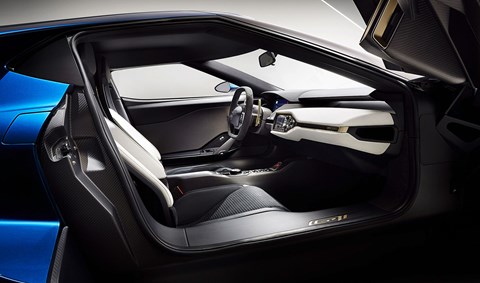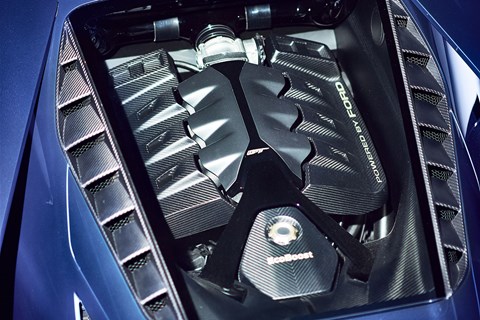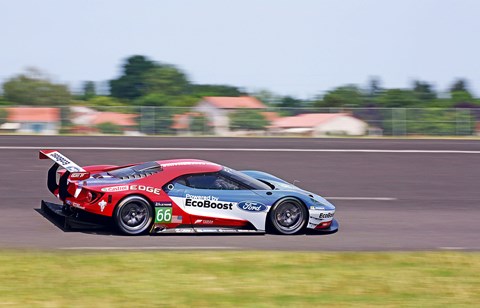► 2016’s most wanted cars #15
► Ford GT makes a return to track and road
► 3.5-litre twin-turbo V6 musters potential 700bhp
At this moment in time, the new Ford GT is like an iceberg in the supercar sea. We’ve seen it, it’s real, we even know when it’s going to arrive; but exactly how big the impact is going to be when it hits depends very much on what’s lying beneath the surface. And the waters surrounding it are deceptively murky, despite initial confirmation of over 600bhp, carbonfibre construction and exceptional aero. It certainly seems like a significant blip on our radar – just how worried should the establishment be?
This has been a secretive project right from the start. Genesis was a small team, located in a Dearborn basement, working late nights and weekends – the only time they could push the car outside and see what it looked like in daylight. The faintest flutterings of rumour heralded its arrival at the Detroit motor show in January, but still it was a shock – suddenly there, a new Ford GT. Not just in concept but as a statement of definite intent, subsequently reinforced at Le Mans in June where Ford unveiled the racing version, and with it a pledge to be on the grid at La Sarthe the following year, the ultimate 50th anniversary celebration of the original’s famous one-two-three victory.
That, however, is about as sentimental as the new GT gets. It most definitely is not some kind of self-congratulatory heritage pastiche. Concrete details include the structure: a full carbonfibre tub, clad in carbonfibre panels, with aluminium components front and rear to cradle the engine, mount the suspension and tolerate crash testing. Much like a modern McLaren. Instead of a fire-breathing, old-school V8, the engine is a race-proven 3.5-litre twin-turbo Ecoboost V6, driving the rear wheels via a seven-speed Getrag twin-clutch automatic. The suspension uses in-board push-rod dampers and an unusual-enough-to-patent spring-and-torsion-bar combination – an ‘active’ set-up to go with the active aerodynamics. The brakes are Brembo carbon-ceramics. The interior features a digital gauge cluster, paddleshifters and a steering wheel as laden with buttons as any from Ferrari. But this lot aside, Ford has been reluctant to reveal any specifics.

Dave Pericak, head of Ford Performance – the organisational umbrella that now encompasses Ford Racing and the blue oval’s high-performance production cars – is keen to apologise for the cloak and dagger. ‘It’s a bit more sensitive right now than it would typically be,’ he says, ‘and that’s only because we are getting ready to race.’ The new GT’s first competitive event is set to be the Rolex 24 at Daytona in January, while the production version won’t be ready until the following November. But even this builds intrigue. The road car and the racing car are different beasts, aren’t they? Think again.
‘Other than the obvious changes you have to make when you go racing – the fixed wing, other rules and regulations you just have to follow – the road car is the race car and the race car is the road car,’ Pericak explains. So much so that it’s difficult to examine one without reference to the other. In fact, we’re going to go out on a limb here and suggest that to find the last time a supercar and a racing car were this closely aligned you’d have to go back to the heady days of the Porsche 911 GT1 and the Mercedes CLK GTR. The GT isn’t being positioned to compete at that level – those cars were gunning for outright victory, while the GT LM racer is entered in the GTE Pro class, several rungs below today’s front-running, hybrid-enhanced LMP1 prototypes – yet it’s clear that Ford is taking the process exceptionally seriously.
‘There is very little lag between road-car and race-car development,’ Pericak confirms. ‘It’s very challenging to do both at the same time, but it’s a huge benefit in that you’re able to design big things into the base car that will help you with racing. The program was conceived from the start as a road car, but once we decided we were going racing they were running in parallel.’
Given this insight it doesn’t take a genius to spot the prioritisation: the compact, teardrop-shaped cabin, so remarkably reminiscent of current LMP1 cars; the extensive use of carbonfibre, and the choice of Canadian race-car engineering firm and carbonfibre experts Multimatic as development and assembly partner. Then there’s the engine’s previous life winning IMSAendurance races, which it’s been doing for the last two years already – including the 2014 Daytona 24 hours and Sebring 12 hours. ‘We’re obviously looking for the best power-to-weight ratio and the smallest frontal area,’ says Pericak. ‘Every curve, every line, everything on this car has been put on there for performance, and especially knowing that we were going racing.’

Yet there’s more, because when asked what he thinks is the most innovative aspect of the new car, Pericak replies that he can’t tell us until it’s taken to the circuit in anger. Holy hell! What else is the GT hiding? Something Ford feels gives it a competitive advantage, that’s for sure – and probably something to do with the torsion bar and spring suspension combo. Since torsion bars and springs usually do the same job, Pericak does admit that part of the system’s smarts is the ability to use both together or lock the springs out, radically altering the effective spring rate, on the fly. ‘It allows us to really change the character of this car. It’s really unique, and really performing extremely well.’ Then he adds, ‘This is the area where I’ve got to watch what I say.’
The most innovative aspect he can talk about? ‘How we’ve been able to lightweight the vehicle, and do it in a way that is extremely balanced.’ Yes, ‘lightweight’ is a verb now, that’s how crucial it is. As for how innovative, check out the cabin. All of the carbon on the inside is part of the structural tub, including the dashboard – a development interior designer Amko Leenarts believes is an industry first. Doing this meant the fundamental bones of the cockpit had to be signed off almost immediately because the tub’s design had to be fixed in order to allow the engineering work to commence.
‘We had a really good design philosophy from day one,’ Leenarts says, looking what you’d swear was relieved, ‘which was about getting it as lightweight as possible, celebrating negative spaces, getting in a simplicity that was easy to read.’ For instance? Fixed seats, the dashtop ‘wing’ that hides the wiring and echoes the exterior’s flying buttresses, and the graphics used in the digital instrument cluster, which are specifically designed for peripheral viewing; ‘We don’t want anything distracting when you are driving that car.’ 200mm of steering wheel reach adjustment and moveable pedals serve to make the driver comfortable, in place of heavier seat adjustment mechanisms. ‘Everything that we’ve done is to take weight out of the car,’ Pericak reinforces. ‘If we didn’t need it, we didn’t put it in there.’
But wait a minute – is this starting to feel like Nürburgring syndrome at its worst? Could the new Ford GT be so focused on delivering a decent racing performance that the road car is in danger of becoming unenjoyable? Even undriveable? Not according to Pericak: ‘I’ve got quite a few hours logged already and when you drive the vehicle it’s not like anything you’ve ever driven before. For me personally, I can say it’s the most well-balanced, well-behaved car that I’ve been in, ever. And it’s extremely intuitive the minute you get behind the wheel.’ What is it like compared to the previous version – 2003’s mid-engined V8-powered reimagining of the GT40? ‘They are in two separate worlds, it’s not even a close competition.’

Ford isn’t officially saying what that means for outright performance yet, but the portents are there. ‘We’re putting a V6 into a supercar,’ Pericak reiterates, ‘and we’re extremely confident that we will be as good or better than the rest of the supercars. And that’s a heck of a statement to make, right?’ The original claim of ‘over 600bhp’ is surely closer to 700 in reality. Target weight must be in the region of McLaren, say 1200kg dry. The aerodynamics are clearly on display. Even with the traction limitations of rear-wheel drive, 0-62mph has got to be sub 3.0sec, and top speed well over 200mph.
Ford also isn’t saying how many GTs it will build, but Pericak confirms ‘it will be a very low number’. Not just because of the production limitations with carbonfibre, but because Ford knows it’s important to maintain a sense of prestige. As for the price, he says we should look to the Aventador; in the UK that means around £266k. Yet he’s adamant Ford is ‘not doing this to try to get rich’. So why is it doing it at all?
‘It’s the embodiment of what’s great at Ford Motor Company. A lot of people ask why are you doing it? And I always love to give the fun answer of “because we can”. But that’s not the real answer. The real answer is we’re doing the Ford GT because we want to showcase and demonstrate our engineering prowess and all of the capability that we have at Ford. Showcase it, be proud of it, and have it be the pinnacle of performance.’
Can the GT possibly live up to that kind of hype? Watch this space…
New Ford GT: road car or race car?

The short answer is both. But there are differences, most of which show the sophistication of the road car. To go racing, Ford has to remove the active aerodynamics, while GTE regulations mandate no more than 500bhp – bad news for rivals, as that’s 100bhp less than what has already proven durable over 24 hours winning races in a Daytona Prototype. Chip Ganassi Racing ran that car, and it will run the GTs, too, alongside Felix Sabates. The actual road car engine is an updated, enhanced version of the racing unit. Can the new GT take class honours on its anniversary return to Le Mans? Dave Pericak: ‘All I can say is this: we’re going to be ready to race and I hope everyone else is too.’